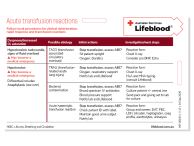Don’t have an account?
Select the donation type you’d like to make
When to suspect this adverse reaction
Acute onset of fever, chills, dyspnoea, tachypnoea, tachycardia, hypotension, hypoxaemia and noncardiogenic bilateral pulmonary oedema leading to respiratory failure during or within six hours of transfusion.
TRALI has been implicated in transfusion of plasma-containing components (red cells, platelets and plasma).
TRALI is a rare but potentially fatal transfusion reaction. It is estimated to occur in about 1:190,000 components transfused.
Usual causes
Various mechanisms have been proposed for the pathogenesis of TRALI. The most widely held view is that passive transfer of human leucocyte antigen (HLA) or human neutrophil antigen (HNA) antibodies in the donor’s plasma are directed against recipient leucocyte antigens. The resulting antigen-antibody reaction activates neutrophils in the lung microcirculation, releasing oxidases and proteases that damage blood vessels and make them leak.
Biological response modifiers (BRM), such as biologically active lipids can accumulate in some cellular components during storage and may be responsible for TRALI in susceptible patients.
What to do
Stop the transfusion immediately and follow other steps for managing suspected transfusion reactions.
Provide cardiovascular and airway support. Administer supplemental oxygen and employ ventilation as necessary. Diuretics are not beneficial.
This may become a medical emergency; support blood pressure and maintain an open airway.
If there is reasonable clinical suspicion of TRALI, contact Lifeblood as there may be implications for other blood components. See next section.
Investigation
TRALI has many clinical features in common with fluid overload or cardiogenic pulmonary oedema and therefore careful clinical assessment is required.
Acute haemolytic reaction or transfusion-associated sepsis may have similar initial clinical findings. A direct antiglobulin test (DAT), full blood count and repeat ABO group may be indicated.
A chest X-ray will show bilateral interstitial infiltrates.
TRALI is a clinical diagnosis. If TRALI is clinically suspected, Lifeblood can arrange HNA and HLA typing on the recipient and the testing of associated donors for HNA and HLA antibodies. Finding these antibodies may support the clinical diagnosis but the testing should not be undertaken in an attempt to exclude the diagnosis of TRALI.
Prepare the following to help with the Lifeblood investigation:
TRALI testing is specialised, so please contact Lifeblood for further support and provide the following details:
- Donation numbers of the transfused products
- Patient observations, symptoms and time of symptom onset
- Relevant medical history
- Investigations performed e.g. Intravenous (IV) fluids, diuretics, mechanical ventilation
A Lifeblood doctor may contact you for further clarification.
Required patient blood samples:
- Pretransfusion serum, and
- Post-transfusion:
- Adult: 12 mL EDTA or ACD and 12 mL serum (clot)
- Child: 2-4 mL EDTA and 1-2 mL serum (clot)
Samples should be clearly labelled pre- or post-transfusion.
Store and transport samples at room temperature as soon as possible after the reaction is reported. Send samples as advised to Lifeblood Transplantation and Immunogenetics Services (TIS).
What happens at Lifeblood?
A transfusion specialist will look at the history and investigations to determine if TRALI is likely.
If so, other blood components from the donor will be recalled and quarantined pending further investigations. The donor will also be recalled for further blood tests.
Results of the TRALI investigations will be reported to the requesting doctor.
Reducing the risk of antibody-mediated TRALI
To reduce the risk of antibody-mediated TRALI, donors with a possibility of having HLA or HNA antibodies either because of a history of pregnancy or transfusion, are not used for plasma components or apheresis platelets.
The below are two significant changes Lifeblood has made as part of its TRALI risk reduction strategy:
1. Male-only plasma
Only blood or plasma from male donors is used in the manufacture of clinical plasma components such as fresh frozen plasma (FFP) or cryoprecipitate.
2. Apheresis platelets collected from male donors
To further reduce the risk of TRALI associated with apheresis platelets, Lifeblood has moved to a plateletpheresis panel comprised of cisgender male donors only.
3. Reduced plasma volume for Pooled and apheresis platelet components
Pooled and apheresis platelets are suspended in Platelet Additive Solution (PAS) with reduced volume of plasma.



